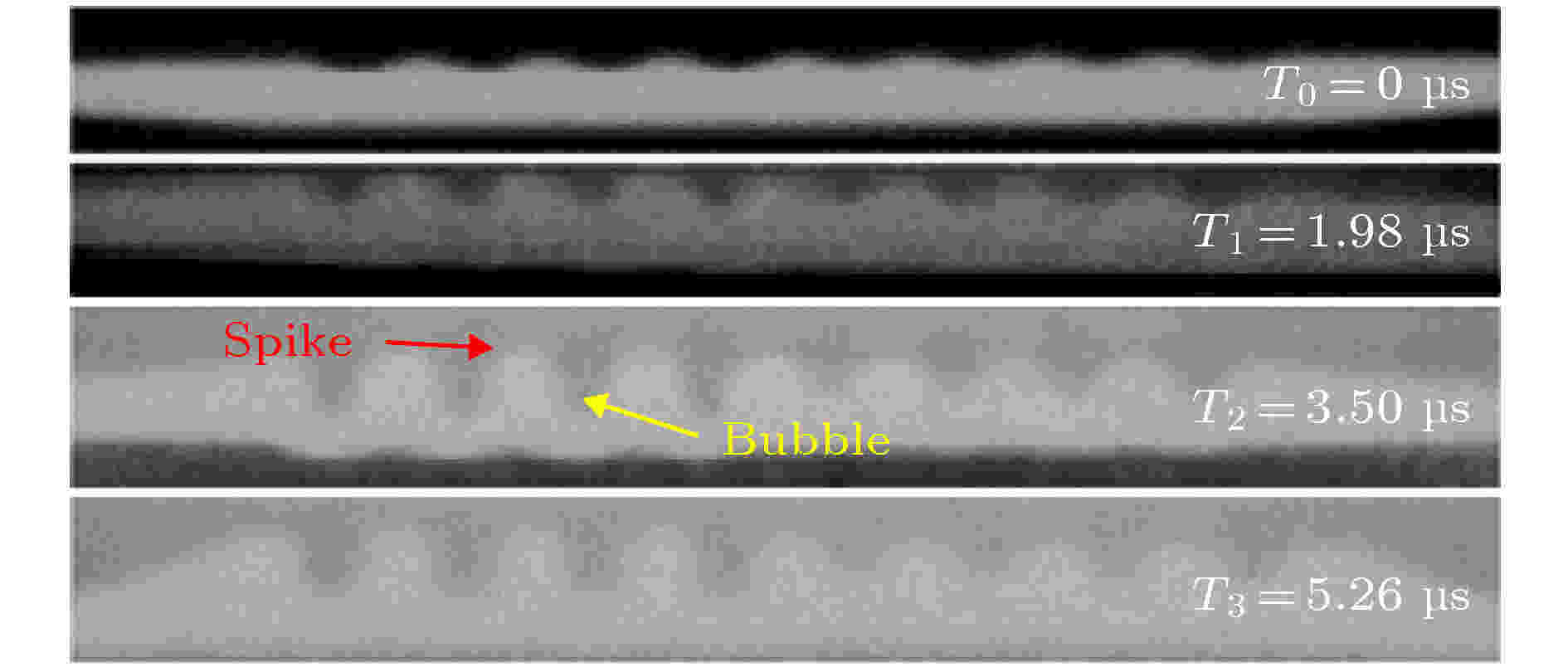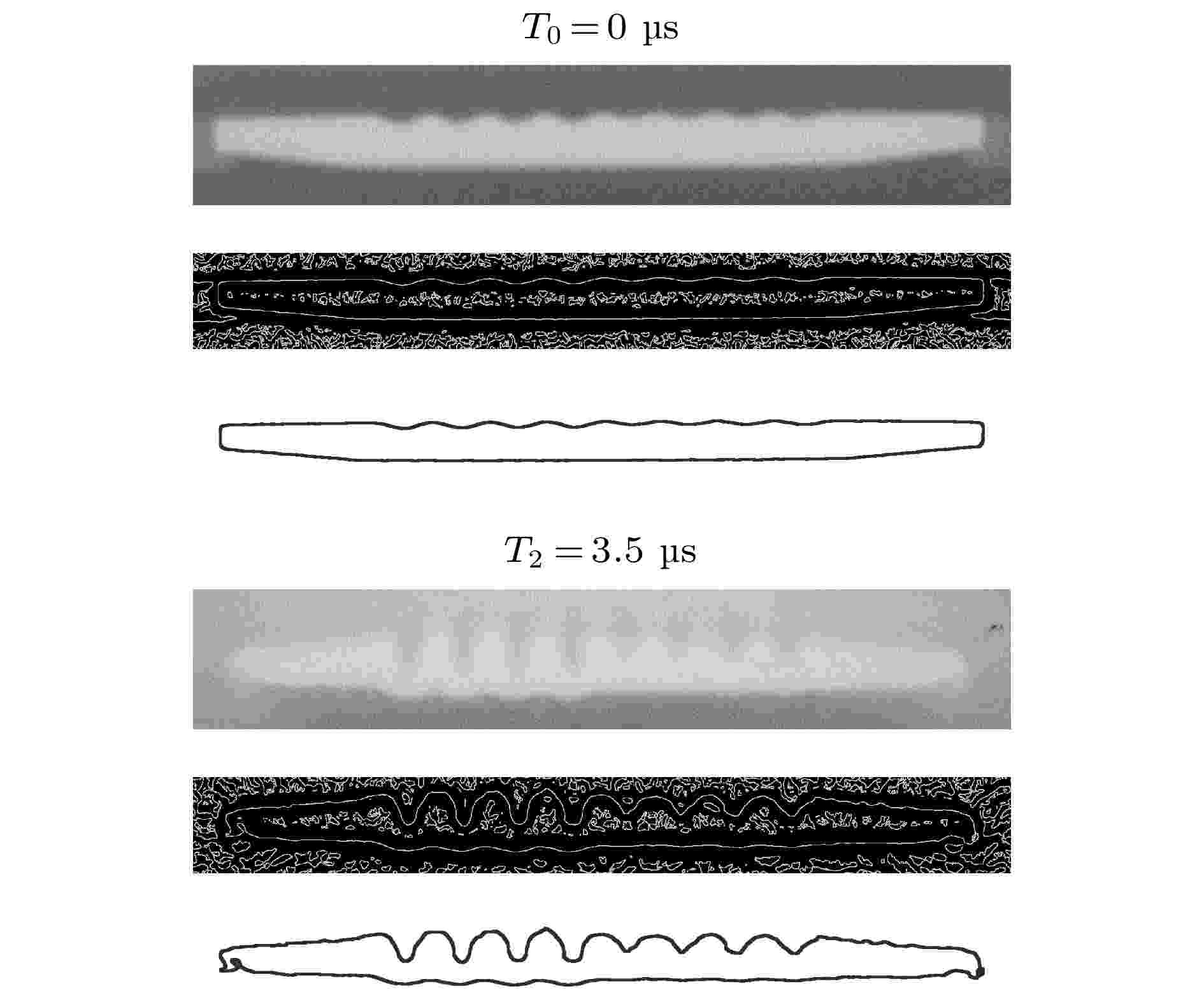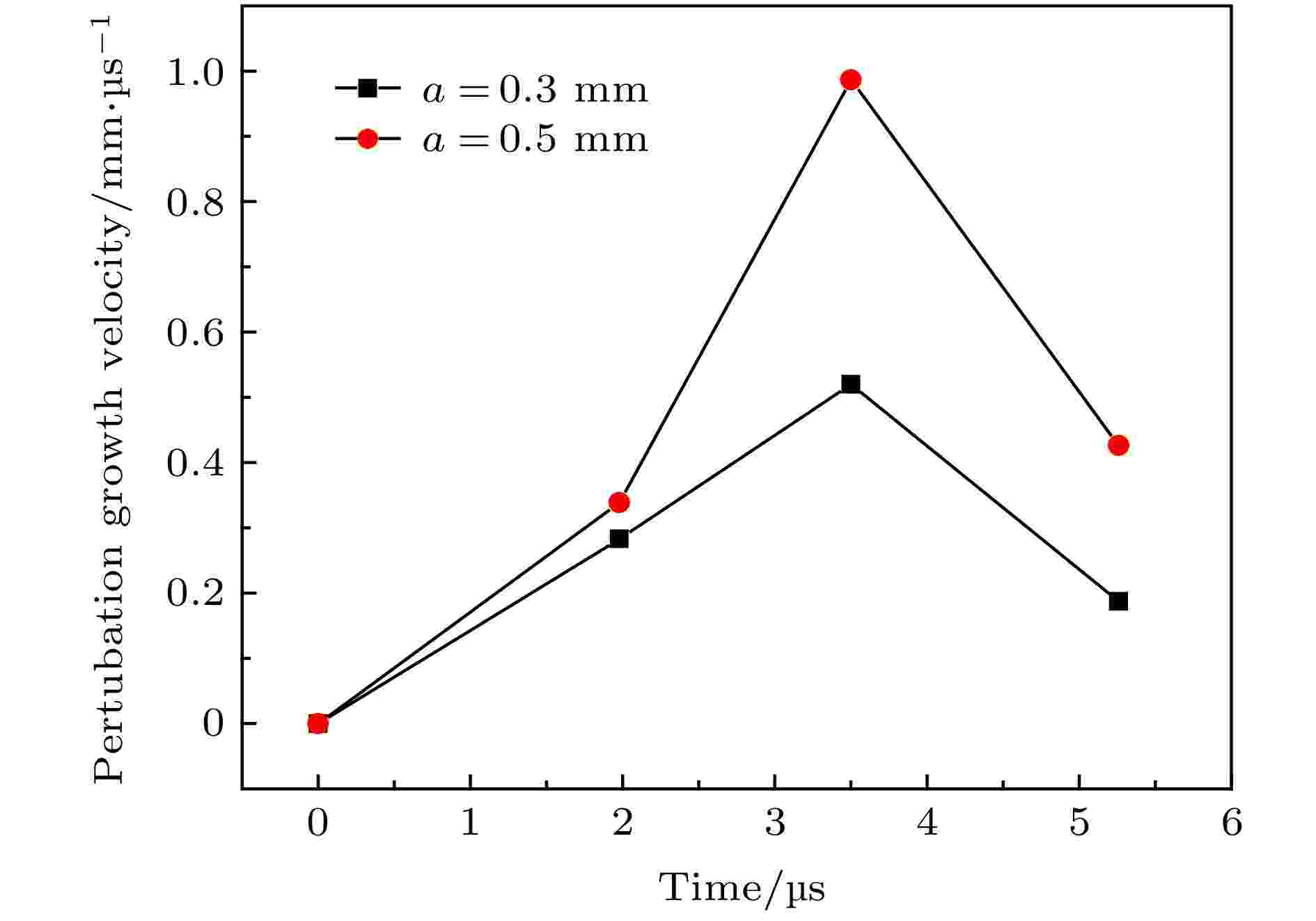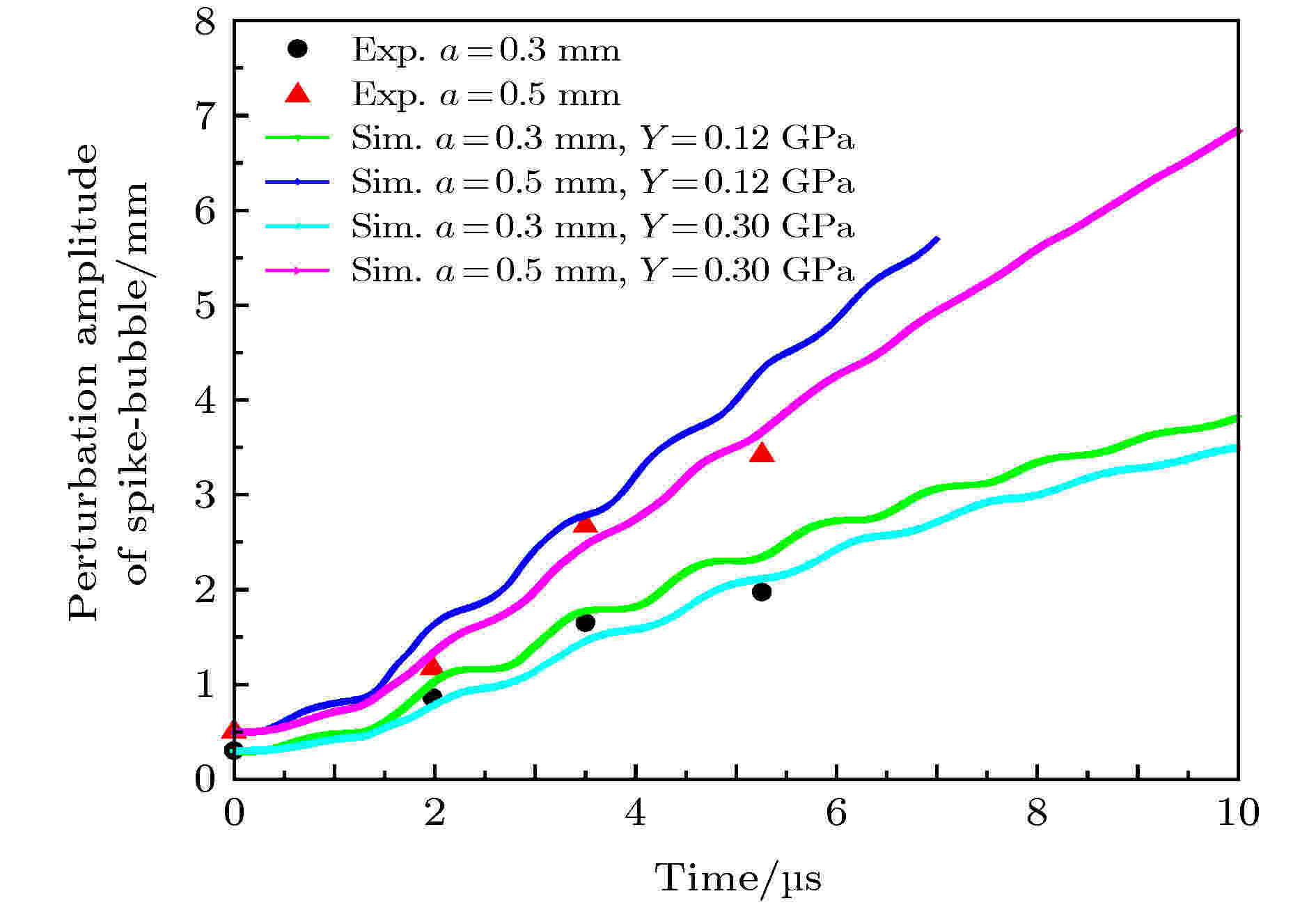摘要: 金属界面不稳定性是内爆物理压缩过程中关注的重要问题, 与传统流体界面不稳定性具有显著区别. 由于相关理论和实验诊断技术的限制, 目前该问题的研究还明显不足. 为加深对金属界面不稳定性扰动增长行为的认识, 本文建立了爆轰加载下高纯铜界面Rayleigh-Taylor不稳定性研究的实验诊断技术和数据处理方法, 得到了扰动发展早期不同时刻界面扰动增长的X光图像. 实验结果分析表明: 在爆轰产物的无冲击加载条件下扰动波长基本保持不变, 而初始扰动幅值越大, 界面扰动增长的趋势就越明显; 同时随着样品前界面扰动的不断发展, 在样品的后自由面也出现了与前界面初始相位相反的扰动特征, 即样品前界面扰动为波谷的位置所对应的后界面先运动而逐渐演变为波峰, 而前界面扰动为波峰的位置所对应的后界面则演变为波谷; 在5.26 μs时刻, 界面扰动幅值增长为初始值的700%左右, 应变率达到了约10
5 /s. 结合数值模拟研究表明: 在此情况下常用的Steinberg-Cochran-Guinan 模型在一定程度上低估了高纯铜材料强度的强化特性, 无法准确地描述强度对界面扰动增长的制稳作用, 从而导致数值模拟结果要大于实验测量结果.
关键词: Rayleigh-Taylor不稳定性 /
爆轰加载 /
扰动增长 /
X光照相 English Abstract Experimental research on Rayleigh-Taylor instability of oxygen-free high conductivity copper under explosive loading Li Bi-Yong 1,2 ,Peng Jian-Xiang 2 ,Gu Yan 2 ,He Hong-Liang 2 1.School of Science, Nanjing University of Science and Technology, Nanjing 210094, China Received Date: 30 December 2019Accepted Date: 25 February 2020Published Online: 05 May 2020Abstract: The instability of metal interface is an important problem in the process of implosion physical compression, which is significantly different from the traditional fluid interface instability. Due to the limitation of related theory and experimental diagnosis technology, this problem is studied still insufficiently. In order to understand in depth the perturbation growth behavior of metal interface instability, the technique for high explosive driven Rayleigh-Taylor instability experiment on the oxygen-free high conductivity (OFHC) copper is developed. The perturbation growth on OFHC copper interface with varying initial perturbation amplitude at a specific time is recorded by radiography. According to the data processing on the X-ray images, the perturbation growth behaviors of the interface at different times are obtained. The experimental results show that the larger the initial perturbation amplitude, the faster the perturbation grows, but the perturbation wavelength of the interface remains almost unchanged at the explosive loading. The perturbation on the front interface will have an effect on the back free interface, and cause some corresponding disturbance to occur on the surface, namely, on the back free interface, the position corresponding to the perturbation trough of the front interface first moves and gradually evolves into a spike, while the position corresponding to perturbation crest evolves into a bubble. The strain rate of instability perturbation growth reaches ~105 /s, and the perturbation amplitude of the interface increases to about 700% of the initial value at 5.26 μs. The corresponding numerical simulation results show that the normal SCG model underestimates the strength of copper and cannot well describe the stabilizing effect of material strength at this high strain rate, thereby leading to the fact that the simulation results are higher than the experimental results.Keywords: Rayleigh-Taylor instability /explosive loading /perturbation growth /radiography 全文HTML --> --> --> 1.引 言 在非稳定的密度分层的状况下(比如低密度流体加速高密度流体, 或者在重力场中低密度流体支撑高密度流体), 流体内部密度不同的区域之间会发生相互渗透进而会发生湍流混合等, 这种现象就称为Rayleigh-Taylor (RT)不稳定性[1 ] . RT不稳定性是超新星爆发和星系演变的重要过程, 是惯性约束聚变和内爆物理压缩问题研究中重点关注的内容[2 ,3 ] . 相对于流体而言, 金属界面上也会有RT不稳定性现象, 金属界面上微小的初始扰动在一定的物质或载荷作用下将会随着时间增长并导致后期的湍流混合, 这种不稳定性的产生及增长会直接影响内爆压缩效率, 造成能量丢失, 从而降低装置实现功能的可靠性. 相对于流体或气体, 金属界面RT不稳定性具有高压、高应变率和大变形的特点[4 ] , 典型的压力范围从10 GPa至百吉帕、温度几百开尔文至千开尔文、应变率105 —109 /s、变形量超过100%. 此外, 金属界面RT不稳定性发展机制与许多复杂物理机理(如微喷等)同时存在并相互耦合, 还会涉及材料本构、冲击相变(熔化)等多物理过程, 与传统意义下的纯流体力学界面不稳定性有很大区别, 这也导致了一些公开发表的文献资料中出现了明显相反的结论[5 -7 ] . 比如, 对于RT不稳定性扰动增长的各种判据中, Miles[5 ] 根据能量平衡方程给出的截止波长判据认为在该截止波长以下的扰动不增长; Drucker[6 ] 利用二维Prandtl解的方法给出的临界幅值判据则认为小于临界幅值的扰动将不会发展; 而Swegle和Robinson[7 ] 通过大量数值模拟研究认为界面扰动局部的应力梯度才是控制RT不稳定性扰动增长的主要因素. 上述文献中都近似将材料假设为理想弹性体, 基于小扰动近似且只考虑了材料在加载条件为常压下的不稳定性发展, 但对炸药爆轰加载等实际问题中样品表面的加载压力始终是处于变化(其加速度并非常数)的情况则研究较少. 此外, 金属界面RT不稳定性扰动处于大变形的运动状态, 具有复杂的弹塑性变形行为, 因此, 上述给出的相关判据都存在一定的局限性. 总的说来, 金属界面RT不稳定性的发展与原始材料界面的初始形状、材料的性质(如强度、模量和黏性等)等密切相关, 而且没有形成统一共识, 需要进一步深入研究. 相对于国外****对金属界面RT不稳定性问题所开展的研究[4 -11 ] , 国内目前的相关工作几乎都集中在流体或者气体介质[12 -16 ] , 涉及金属材料的界面不稳定性研究则大多针对类似微喷和Richtmyer-Meshkov(RM)不稳定性开展了较多的实验和数值模拟工作[17 ,18 ] . 对于金属界面RT不稳定性的研究主要集中于数值模拟[2 ,19 -22 ] , 结果表明RT不稳定性扰动增长早期其振幅以指数规律增长, 并且扰动增长过程受屈服强度的影响较大; 但由于金属界面扰动增长的物理机理和动态响应过程较为复杂, 现有的理论分析和数值模拟难度较大, 目前相关研究工作明显不足, 此外更缺乏相应的实验数据支撑. 在此情况下, 本文将以高纯铜为例, 开展爆轰加载下金属界面RT不稳定性研究, 拟建立相关的实验和测试诊断技术, 分析界面的初始特征和材料强度对界面扰动发展的影响, 加深对金属界面RT不稳定性扰动发展的相关物理认识, 以期为内爆物理模型的设计和相关工程应用提供一定的参考.2.实验技术与方法 为了研究金属材料(以高纯铜为例)在高压、高应变率加载下的RT不稳定性扰动增长行为, 采用了炸药爆轰的方式来加载高纯铜样品, 所采用的实验装置和整体测试布局借鉴文献[10 ], 具体如图1 所示. 实验中采用了直径为Φ 100 mm的平面波炸药透镜, 将雷管的点起爆转化为平面爆轰波并进一步起爆Φ 100 mm × 10 mm厚的主炸药; 在主炸药与高纯铜样品间设置了一定的间隙(宽度为3.5 mm), 炸药爆轰产物经此间隙等熵膨胀卸载后再加载于待研究样品, 一定间隙的设计会调制加载冲击波的前沿和幅度, 可将接触加载情况下形成的冲击加载变为压力逐渐上升的无冲击加载形式(近似于准等熵加载), 这样可以避免在样品中由于冲击造成很高的温升或引起层裂现象, 也可以避免由于强冲击波造成其他形式的扰动发生. 目前, 炸药与样品间间隙为数毫米量级的爆轰加载被当作平面一维、球面爆轰驱动准等熵加载的一种设计调控手段被广泛使用. 为了获得界面扰动增长信息, 在实验诊断上采用低能450 keV的脉冲X光机照相以记录高纯铜界面RT不稳定性在不同时刻的扰动增长状态. 但限于目前的实验诊断能力, 每发实验只能获取一个特定时刻的界面扰动X光图像, 因此为了获得不同时刻的界面扰动增长信息就需要重复开展多发实验.图 1 爆轰加载下金属界面RT不稳定性实验布局Figure1. Scheme of the experimental assembly of high explosive driven metal RT instability.Φ 66 mm; 同时为了防止样品在飞行过程中边缘发生弯曲, 在样品背面的边缘部位加工了一定的斜面(通过前期的数值模拟, 将倾角设为5°), 这样可以有效地避免样品在飞行运动过程中由于边侧稀疏导致边缘弯曲并造成对中心区域扰动增长信息的X光诊断的影响. 在高纯铜样品前界面(加载面, 靠近炸药一侧)预制了特定的正弦型初始扰动(实验样品前界面的初始扰动见图2 ), 扰动的初始波长为5 mm, 为了尽可能获得较多的实验数据, 样品设计时在加载面预制了初始幅值a 为0.3和0.5 mm两种不同的初始扰动状态(扰动幅值定义为扰动界面波峰到波谷的距离), 而样品的后自由面为完整的平面.图 2 预制初始扰动的高纯铜样品实物图与剖面图(单位: mm)Figure2. Pictures of a pre-machined sinusoidal perturbation oxygen-free high conductivity copper target.3.实验结果与分析 根据图1 所示的实验装置和测试系统布局, 开展了3发爆轰加载下高纯铜界面RT不稳定性实验, 采用低能450 keV的脉冲X光机对界面的扰动增长信息进行照相诊断. 3发实验清晰地给出了初始扰动波长为5 mm的高纯铜样品在不稳定性扰动发展早期T = 0, 1.98, 3.50和5.26 μs四个不同时刻界面扰动发展的X光图像(见图3 ), 其中X光机照相的时间零点为从爆轰产物到达样品前界面的时刻, 图像的上方为爆轰产物, 高纯铜样品的运动方向向下. 从图3 可以较为清晰地看到在爆轰产物的加载下高纯铜样品前界面扰动幅值随着时间而逐渐地增长, 然而界面的扰动波长却基本不变. 不同初始幅值的界面扰动在相同时刻的扰动增长特征也基本一致, 界面初始扰动对应的波峰位置在爆轰产物的加载下形成了明显的“尖钉”, 而波谷位置则形成了所谓的“气泡”. 从图3 中的X光图像上还可以看到在扰动增长的早期, 样品内部没有出现肉眼可见的空洞或裂纹, 说明本实验采用的爆轰产物加载方式下高纯铜样品没有出现层裂现象. 然而随着界面扰动的进一步发展, 以及在后期出现的大变形现象, 尖钉会不可避免地发生断裂或破碎.图4 所示.图 3 不同时刻界面扰动增长的X光图像Figure3. Radiographs of the perturbation growth at the different times.图 4 数据处理后样品的边界图像Figure4. Specimen edge images of after data processing.表1 (扰动幅值的测量误差主要依赖于统计分布, 其不超过0.1 mm).实验 初始波 初始幅 当前幅 照相 1 5.0 0.3 0.86 ± 0.05 1.98 0.5 1.17 ± 0.05 2 5.0 0.3 1.65 ± 0.05 3.50 0.5 2.67 ± 0.05 3 5.0 0.3 1.98 ± 0.05 5.26 0.5 3.42 ± 0.05
表1 不同时刻高纯铜样品界面扰动特征参数Table1. Interface perturbation characters of the high purity copper at different times.图5 所示. 界面扰动的初始幅值越大, 在相同时间范围内扰动增长的速度和加速度就越大, 这主要是因为在扰动波长相同的情况下, 初始幅值越大其界面的曲率也就越大, 从而爆轰产物作用在尖钉位置两侧所形成的汇聚压力也就越大. 因此, 在相同的加载压力条件下初始幅值越大的界面扰动更容易发生增长或变形. 本实验中爆轰产物经过间隙膨胀后加载于样品表面, 其类似于准等熵加载形式, 在1.98—3.5 μs时刻界面加载压力达到了最大值, 此时界面扰动增长的加速度也最大, 随后来自于炸药的卸载稀疏波导致了加载压力逐渐降低, 因此, 在3.5 μs后界面扰动的速度呈现了下降的趋势.图 5 扰动幅值的增长速度随时间的变化Figure5. Change of the perturbation growth velocity with time.图3 给出的X光图像中还可以看到, 在3.50 μs的时刻, 样品初始状态为完整平面的后自由面处也出现了相应的界面扰动, 并与前表面的扰动特征正好相反. 由于炸药爆轰产物的阻抗相比高纯铜的较小, 在加载前界面处向样品内透射的冲击波速度要小于爆轰产物的加载速度. 因此, 样品内部冲击波阵面的几何形态与初始界面扰动的特征类似, 而在高纯铜样品中其波峰位置的等效厚度要大于波谷位置处的等效厚度, 因此, 波谷位置处的冲击波要先于波峰位置处的冲击波到达样品后自由面, 然后反射为稀疏波并向样品前界面传播. 从而样品前界面为波谷的位置所对应的后界面先运动而变为波峰, 而前界面波峰的位置所对应的后界面则变为波谷. 这从实验上证实了样品前界面的初始扰动会随着时间逐步耦合到后界面, 并且在后界面形成的扰动也会在冲击波持续加载下逐步增长(类似于RM不稳定性扰动增长).5 /s)情况下的弹塑性变形特性, 具体材料参数见文献[23 ]. 针对高纯铜界面初始扰动波长为5 mm, 初始幅值分别为0.3和0.5 mm的两种情况进行了数值模拟, 相关计算结果和与实验结果的对比如图6 所示. 从图6 可以看到, 数值模拟的结果在扰动增长的趋势上与实验结果符合, 初始幅值较大的扰动在不稳定性的发展过程中, 扰动幅值的增长也越大. 但在X光出光时刻, 数值模拟给出的界面扰动幅值均要大于实验结果, 随着扰动的进一步发展, 数值模拟结果也越来越偏离实验结果. 对于固体材料的界面不稳定性发展而言, 材料的强度在不稳定性的发展过程中起着抑制扰动增长的作用. 因此, 对数值模拟结果要高于实验结果的主要原因可能是我们采用的SCG模型没能较为准确地描述高纯铜材料在高应变率下的强化特性, 低估了材料的强度. 因此, 我们将高纯铜的屈服强度Y 从0.12 GPa增加到了0.3 GPa后再次进行了数值模拟, 计算结果与实验结果就更加接近. 此外, 图6 中数值模拟结果给出的界面扰动幅值随时间的增长曲线呈现出一定的振荡, 其振荡周期约为1.3 μs, 这与本实验冲击波在高纯铜样品内部来回反射所需要的时间也基本一致.图 6 界面扰动幅值随时间增长的实验和数值模拟结果对比Figure6. Comparison of the perturbation growth between experiment and simulation.4.结 论 建立了炸药爆轰加载下高纯铜界面的RT不稳定性实验与诊断测试技术, 以及给出了相应的数据处理方法, 并清晰地获得了界面扰动发展早期不同时刻的扰动增长X光物理图像. 实验结果表明: 在爆轰产物的准等熵加载下, 高纯铜前界面的初始扰动波长基本不变, 而其幅值随着时间不断地增长, 在5.26 μs时刻扰动幅值增长到约为初始值的700%, 应变率可达到105 /s; 前界面的扰动增长会逐渐导致后界面也出现前界面初始相位相反的扰动特征, 即样品前界面为波谷的位置所对应的后界面先运动而变为波峰, 而前界面波峰的位置所对应的后界面则变为波谷; 在初始扰动波长一定的情况下, 初始扰动幅值越大, 界面扰动增长的幅值和速度也越大; 数值模拟结果表明, 常用的SCG模型参数未能准确地描述实验中界面扰动幅值的增长变化, 这主要是因为低估了材料在高应变率下的强化特性, 因此数值模拟的结果要大于实验所测量的扰动增长结果.  图 1 爆轰加载下金属界面RT不稳定性实验布局
图 1 爆轰加载下金属界面RT不稳定性实验布局 图 2 预制初始扰动的高纯铜样品实物图与剖面图(单位: mm)
图 2 预制初始扰动的高纯铜样品实物图与剖面图(单位: mm) 图 3 不同时刻界面扰动增长的X光图像
图 3 不同时刻界面扰动增长的X光图像 图 4 数据处理后样品的边界图像
图 4 数据处理后样品的边界图像 图 5 扰动幅值的增长速度随时间的变化
图 5 扰动幅值的增长速度随时间的变化 图 6 界面扰动幅值随时间增长的实验和数值模拟结果对比
图 6 界面扰动幅值随时间增长的实验和数值模拟结果对比